
Introduction
Drafted
Operation Torch
Conversation Part 1
Sicily
Conversation Part 2
Anzio
Breakout
France
Germany
Austria
![]()

France: August 1944 - February 1945
Operation Dragoon
The easy life in Rome could not last so the 3rd Division was sent back to the staging area of Pozzuoli near Naples — we still had a big job to do. In Naples I was given the job of taking photos of Cub planes taking off from our "LST Carrier" during a trial run.
Before the landing in Sicily the 10th Engineers built a ramp on the fore part of an LST so Cub planes could be transported to and take off from the landing site where they could be a valuable asset for observation. The idea proved its worth and now the Navy was asked to build a ramp on an LST for the next landing. All went well until one of the planes got into trouble at the start and wobbled down the ramp and over the side into the water. I was on one of the gun turrets at the fore part of the ramp at one side. Well, the plane went over me as I ducked under the ramp. The film pack of a 4x5 Graflex had a slide which had to be removed before taking a photo and I had placed it along side of me. When I went to replace it in the film pocket it was broken. The pilot got wet, and the plane was recovered. A stiff wind was blowing into my face at the time — a crosswind.
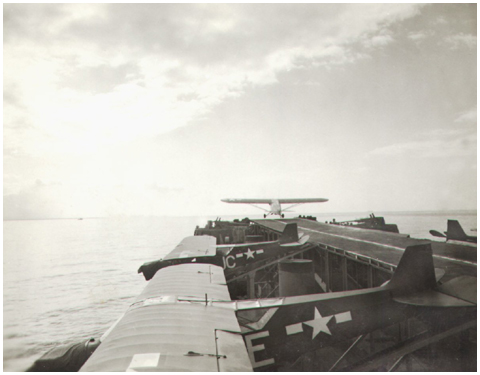
Takeoff from LST 906. This "LST Carrier" is an improved version of the Sicilian prototype and was built by the Navy for Southern France.
We got loaded again on all the ships the Navy could find, and we headed north. We hoped this would be our last D-Day. We paused at the island of Corsica and I have never seen such beautiful water and shoreline.
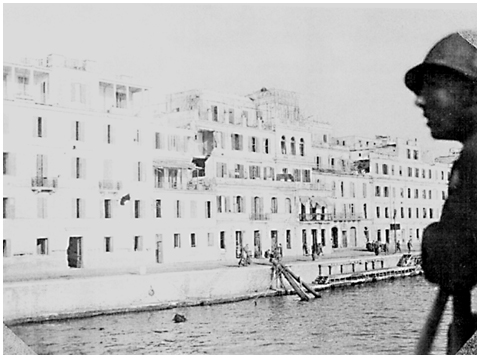
The docking and quay facilities of Pozzuoli were again active, loading and unloading ships of all kinds to supply the needs of war and feed the people of Italy. Pozzuoli was the staging area for Anzio and now it again became a base for another D-Day in southern France.
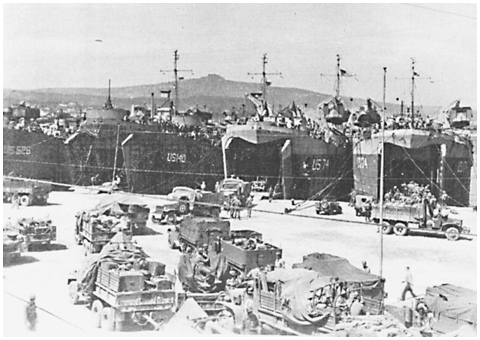
The LSTs are side by side and have opened their great maws feeding their hold with two-ton trucks that have backed in to be later disgorged on the beaches of southern France.
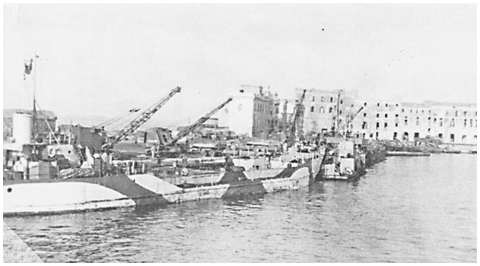
Small craft probably LCTs along a wharf at Anzio.
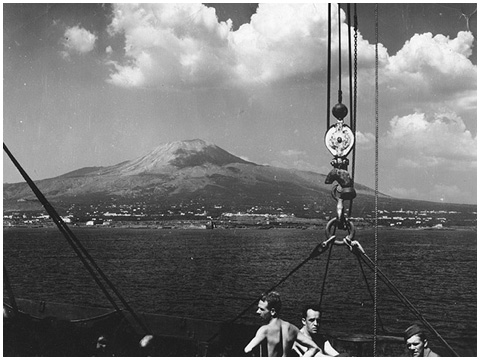
Goodbye Mt Vesuvius. Behave yourself!
I was assigned to take photos of the troops and equipment, unloading from the numerous craft on Red Beach near the sea resort of Cavalaire. The day was wonderful, sunny with beautiful clouds seaward. I thought about the beautiful beaches of the Riviera and the beautiful French girls sans bras that I had heard about. The beach was there but the girls didn't show.
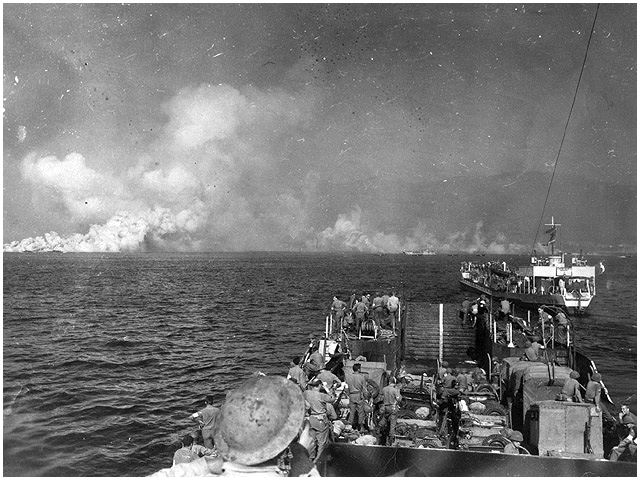
My cruise ship, a British-operated LCT is approaching Red Beach on the French Coast. The white clouds are smoke-generated to obscure whatever. That guy without the helmet standing in the jeep bed is me.
The sparse defense by the Germans was soon overrun; although a few casualties occurred reportedly caused by mines. The unloading of the various craft was orderly and the way landings should go, but there is always a glitch. The L-5 cub planes I mentioned before took off from the LST Carrier heading for a small landing strip that the 36th Engineers had built just off the beach. An L-5 came in to have a look-see of the strip before landing. The small plane was less than 1000 feet in the air when he was suddenly stopped by hitting the cable from a barge balloon which had been anchored on the beach by the Navy which happened to line it up with the airstrip.
The cable hit the plane about the middle of the wing and the plane spun around the cable. The cable broke away from the balloon and must have fell in such a manner as to part from the plane. The plane flopped around but the pilot got control and flew on. It sure was his lucky day.
Balloon cables were equipped with an explosive charge fastened to the cable. This explosive is meant to explode on contact with a plane should such like this happen. In this case, the balloon filled with helium took off skyward , the cable fell and the explosive remained.
Just a few feet off the beach below, five or six German prisoners were waiting under a lone tree to be taken aboard a ship to a PW camp. They were, as I remember, young lads and I had already taken their picture. The balloon cable's explosive charge landed were they sat. There were casualties and I believe a death or so. Most anything can happen in war.
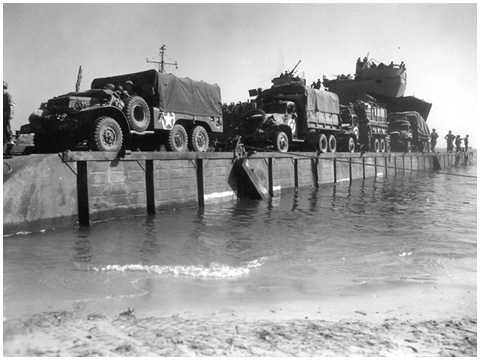
An LST has opened its great maw and trucks are being disgorged on Red Beach, none the worse for the experience. This floating wharf is assembled from several hollow blocks brought to the beach on the side of the LST. They are used where the water on the beach is too shallow for a large LST to unload.
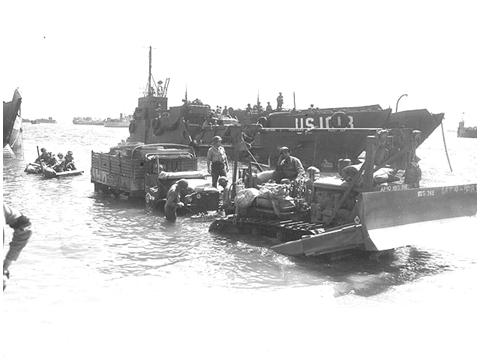
A two-ton truck in trouble and is getting towed by a bulldozer from the 36th Engineers who were the beachmasters for this landing. The bulldozer was one of the sweethearts of this war and sure saved a lot of backbreaking work.
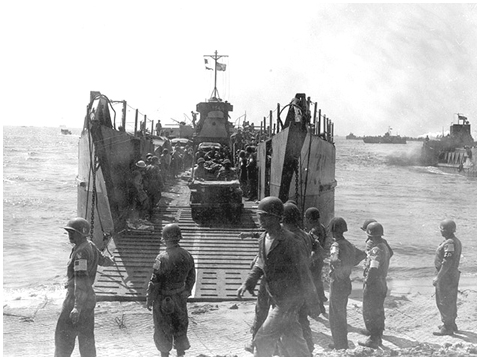
This is the way the LCT hoped to beach itself, everybody high and dry.
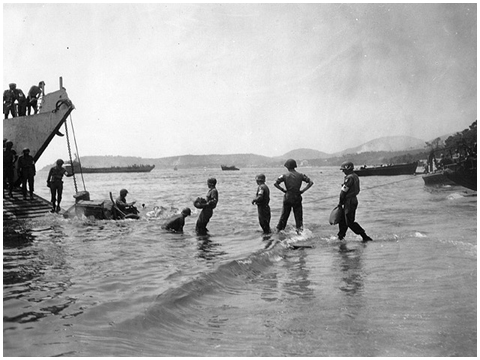
A jeep in trouble is rescued by a tow from a truck winch. All or almost all vehicles were waterproofed and the engines would run submerged. This waterproofing was removed after reaching shore.
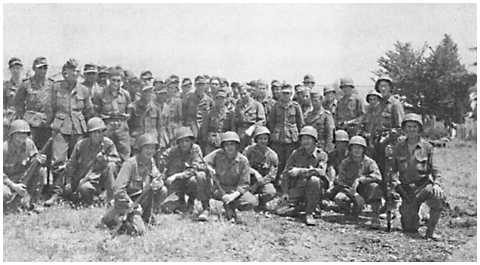
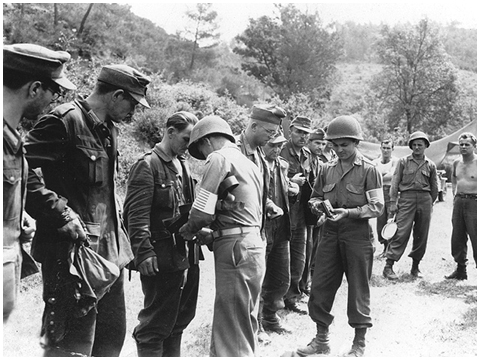
Soon after landing in southern France 28 German soldiers walked out of the brush and gave themselves up to the 3rd Signal Co.. It isn't often a service company can capture the enemy, even if they walk into the bivouac to give up. So our heroes have to get them to pose for a photo so they can back up their brag. In the lower photo Lt. Daub is looking for a better watch and other souvenirs. Note the nice clean arm bands that we wore on D-Day and the cook on the right without a shirt. He is wondering if the is going to have to feed that bunch. These Germans look happy, and I would be too, as they will be going to America to sit out the war.
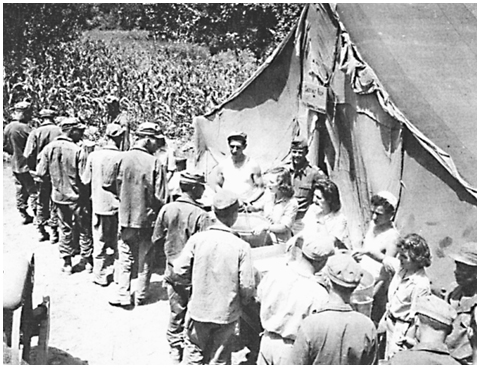
The Red Cross girls drew GIs from an ordnance company in fatigues. They served regular chow and a couple of doughnuts; it was nice to see an American girl.
Montelimar
The Germans defending the coast had retreated but blown bridges and rearguard actions were standard for retreating armies. North of the town of Montelimar the east bank of the Rhone valley narrows sharply, and a long steep ridge running from the east terminates in a formidable bluff just above the highway. General Truscott was able to put up a powerful road block at this site and the resulting devastation and carnage were truly awesome. For eighteen kilometers north and south of Montelimar, the highway was a smoking double-column of knocked out vehicles of all descriptions — dead horses and dead men. There was no stretch of twenty feet in the whole distance which did not contain some remnant of destruction. Montelimar netted some 5,000 prisoners, destroyed more than 4,000 German vehicles, and eliminated the 338th and 189th divisions. Several 280 mm and two 380 mm railroad guns provided the French with scrap iron. I had the honor, if you call it an honor, of taking photos of a part of this wreckage.
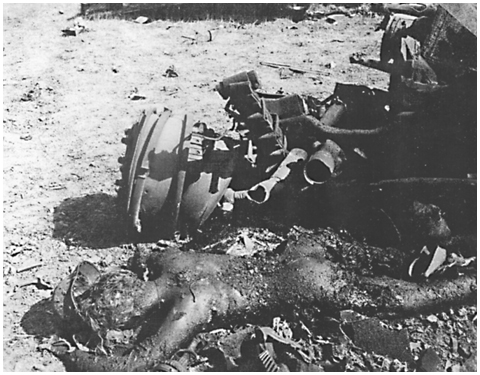
I took several film packs of photos of the carnage and destruction along a distance of less than probably a mile and this is the only one I have left but it tells the story. I sent most of my photos from France to a group of French men that have organized a Seventh Regiment reenactment group in southern France. I wonder at times if we could have convinced the Germans to surrender and avoided this carnage.
To the Vosges
As the days went on, Jack Cole did considerable aerial work and the other photographers were busy. I worked many hours in the lab turning out the prints of the photos they had taken. The Division also had a review and the men receiving awards had their photo taken.
Jack Cole and I were in an area where World War I was fought. We came upon some French citizens who showed us a bank that was made up entirely of human bones. The French citizens told us the bones were French soldiers buried in a mass grave during WWI. With all these wars, the French sure can get themselves between a rock and a hard spot.
During a move in the vicinity of Dijon, France, the Fuzzy's Folly group was almost dealt a blow that it might not have recovered from.
Jack Cole and myself were in the lead jeep of the company convoy traveling to a new bivouac area. The vehicles were well spaced at least a half mile apart traveling along this hard surfaced tree-lined, two lane road. It was a beautiful day and the countryside in this part of France is especially scenic. I heard the terrifying sound of strafing and looked behind to see two ME109s wingtip to wingtip strafing the column. All I could see were the red fire from the guns and leaves falling from the trees. We were in the middle of the road and no bullets hit our jeep. Jack hastily pulled off the road to the right and got stopped. I backed out and ran into a stone wall with both hands outstretched. After collecting ourselves we traveled to our new bivouac area. If I remember right, our darkroom trailer collected a bullet hole or two but nothing that some canvas and glue could not fix.
With my wrist hurting I reported to the medics that evening. I got a bandage and splint on my wrist and the medics gave me a pill and a plane ride to the General Hospital in Naples. White sheets; Purple Heart; rest. I got my head partly screwed back on and then headed back to France in an LCI. There was a terrible storm at sea but I landed at a nasty replacement depot and then spent five days on a forty and eight to get back to my company at Remiremont.
Remiremont to Strasbourg
From Remiremont the division pushed to St. Die and from there into Strasbourg on the west side of the Rhine River. It was now late November. The Germans put up a stubborn resistance along their winter line but their stand was futile.
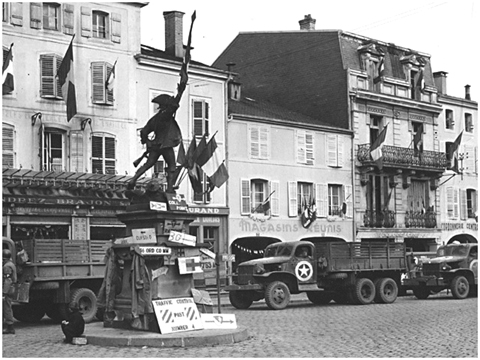
This old statue in the town square of Remiremont was put to good use holding up signs showing the directions of various units of the 3rd Division. Remiremont was one of the larger towns on the Moselette River and it was an important rail and road hub. This was the town where I left the famous "forty and eight" train returning from my hospital stay at Naples. Do you know that there is an active organization called the forty and eight's that anybody who rode one of those beasts can join. They harken back to WWI days.
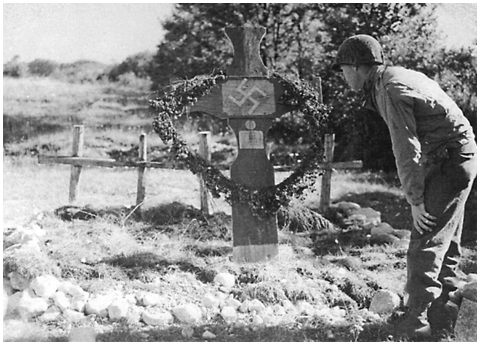
A German officer and five of his soldiers are buried here. Quite typical of the burial blots we saw in Italy and France.
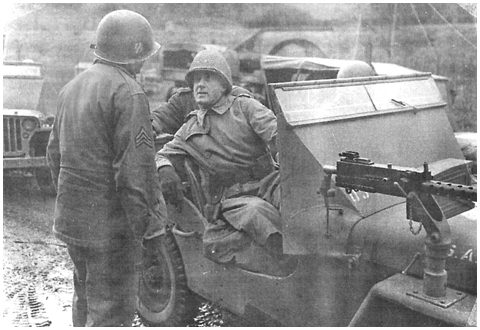
General Brookes, commanding general of VI Corps stops on an inspection of the front and questions a 3rd Division soldier. Get a load of the protection on his jeep! Brookes took over from General Truscott in October 1944.
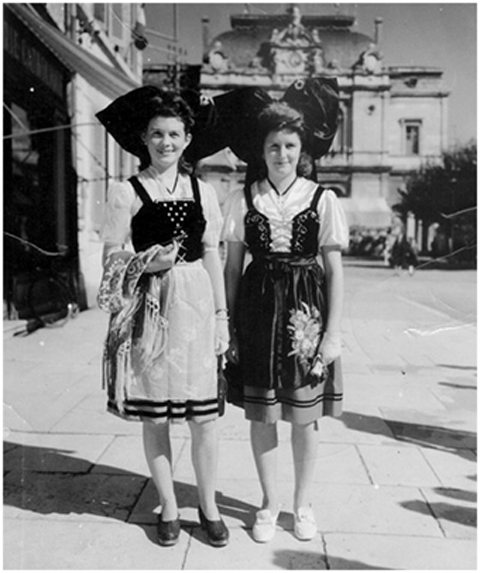
Pretty Alsatian girls in their pretty dresses and their elaborate chapeaux. Nobody but Jack Cole could find and take photos of such pretty girls.
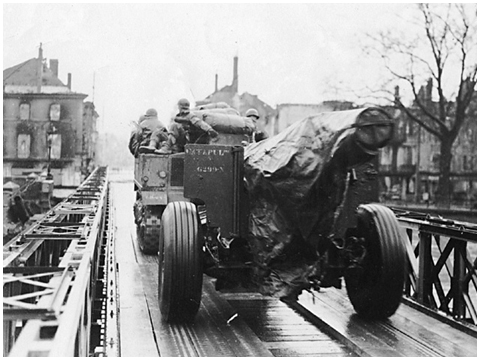
This top photo shows a versatile Bailey Bridge. Sir Donald Bailey, born in 1901 in England, was the engineer that invented the bridge. The bridge was designed for rapid construction from interchangeable latticed steel panels that are coupled with steel pins. An example of the speed these bridges could be constructed is that a 240 foot span was made in one night. It was used to reinforce a multiple arch bridge that had been damaged. This bridge was constructed at St. Die. These bridges could be built to hold our heaviest loads and could be transported by our two-ton trucks.
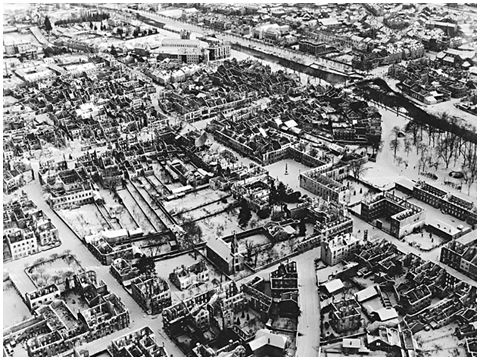
St. Die was methodically torched by the Germans because it was the center for French guerilla activity and headquarters for the FFI. The burning of St. Die was to stand as a symbol of retribution by the Germans. The citizens of that town paid dearly. If I heard right, this town had been also burned during WWI. St. Die was named after a sixth century monk Saint Deodatus who established a monastery there. A cathedral dating from the 11th century was also in St. Die.
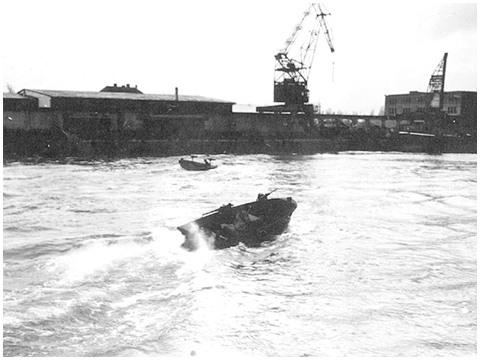
The Rhine River was patrolled by men of the 10th Engineers. These guys had training way back to Ft. Lewis and Ft. Ord when the 3rd Division was trained amphibious. This boat is mounted with two .50 cal. machine guns that were fired at anything that looked like it needed a few rounds.
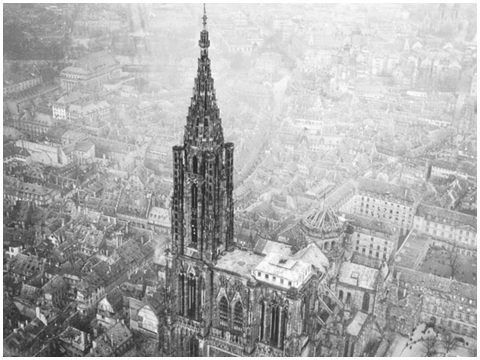
The famous Cathedral at Strasbourg. The people of Strasbourg were a bit unhappy with us as a few bombs dropped without purpose had hit it.
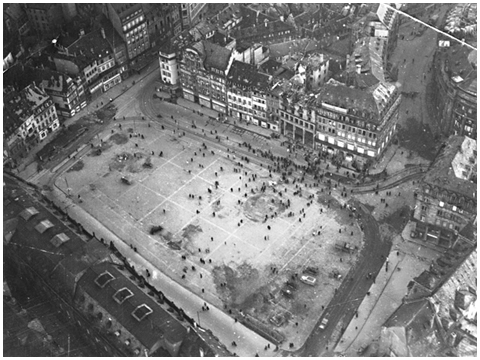
Place Kleber in Strasbourg. Photo by Jack Cole.
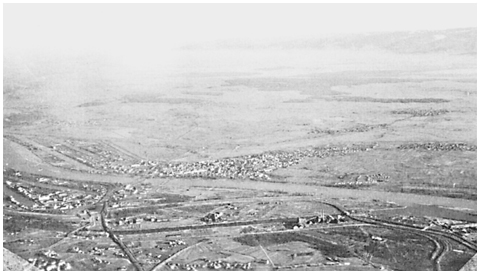
The Rhine River flows north, to the left on this photo. A bridge across the river at the town had been destroyed but looks like other bridges had been built by the time this photo was taken. The canals on the side of the river were used for transportation by barges. Jack Cole took this shot.
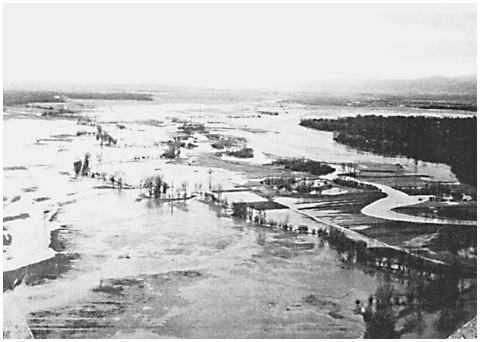
The area that was flooded by the Germans at Strasbourg. Jack Cole took this shot.
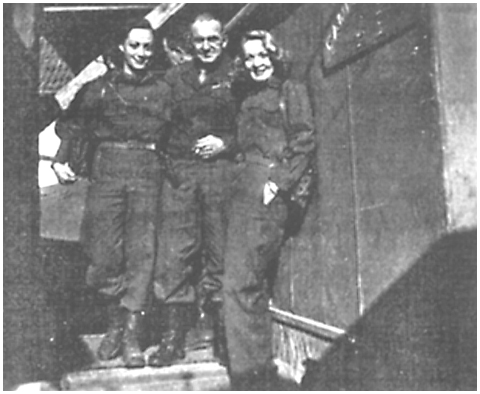
Marlene Dietrich and companion visit the 3rd Division troops with General O'Daniel as host. Marlene visited and entertained our troops several times while we were overseas, and she was much appreciated.
Colmar Pocket
The French were trying to push the Germans from what was known as the Colmar Pocket and the 3rd Division was sent to help. We relieved the 36th Division on the line.
The lab work in developing and printing almost came to a standstill during the coldest of the fall and winter. The developing solutions were freezing. To work right they must be between 68 and 72 degrees. The taking of photos did not stop but since the prints had to be processed a way was found. We had daylight tanks that could be loaded with film in the dark and then development was done in the daylight. We got electricity from the company generator.
Fighting in the Colmar Pocket was vicious especially under cold, wet and snowy weather and the Germans flooded the area with mean troops. The Germans were finally pushed back and the pocket was eliminated as Spring came.
A sad memory for many GIs in the 30th Regiment occurred on January 23, 1945 after the 30th captured a bridge across the Ill River at Maison Rouge to move on Redwihr and Holtzwihr to the south. The bridge was not capable of handling heavy tanks. The Tenth Engineer Battalion had prepared to reinforce this bridge with treadway sections so tanks could cross. This was done but they lacked 15 feet to complete the span. Regardless, the regimental commander ordered a tank to cross. It negotiated to the unsupported part, and the bridge collapsed and dumped the tank in the river.
This meant the forward element had no protection on either flank, and the Germans attacked with ten tanks and tank destroyers and about 100 infantry. The 30th had not established artillery control, so the Third Battalion was forced into a hasty retreat with many killed, wounded and captured. The First and Second battalions also were hard hit. The regiment lost 350 men, most of them captured. The retreating men had to cross the river, mostly by swimming, so they were in need of all necessities: dry winter clothes, warm places, warm food and weapons. They again were able to return to combat and were successful by the 26th of January.

This photo shows the ill-fated tank at the Maison Rouge bridge being recovered from the river. There was considerable finger pointing for this mistake, but eventually the blame was put on the right people.
Audie Murphy's bravery won him a Congressional Medal of Honor during this battle. General Jean de Lattre de Tassigny, Commander of the French First Army, pinned the Order of the Croix de Guerre to the 3rd Division Colors. He then conferred the Legion D'Honneur, Third Degree and the Croix de Guerre with Palm on 3rd Division General John W "Iron Mike" O'Daniel. We had 317 killed, 1,410 wounded and 323 missing in action along with 2,550 non-battle casualties from Jan 23 to March 14, 1945.
Next, the Division was rested and readied to cross the Rhine River and penetrate the Siegfried Line.
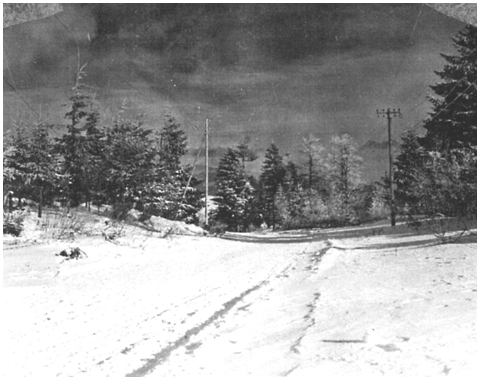
The winter wonderland in the Vosges Mountains reminded me of western Montana. These conditions were not the best to drive the German Army from their defensive positions.
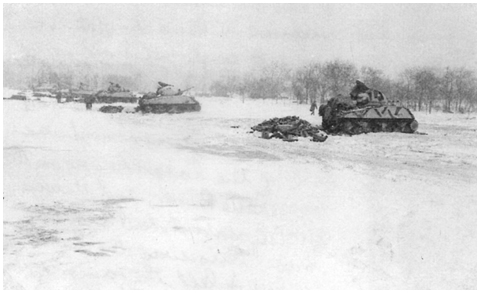
Snow, ice and cold are not good conditions for tank warfare so the tanks were lined up and used like artillery. It looks as if they had good hunting from the size of the pile of spent casings. The tanks also have their winter camouflage paint on.
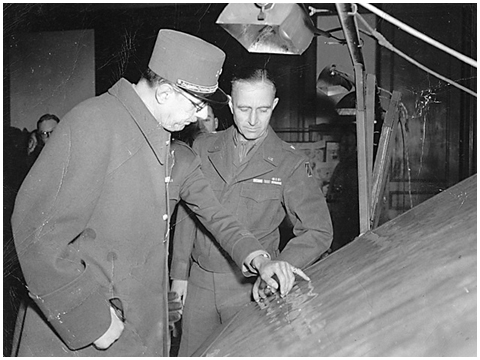
Brigadier General Robert Young, acting division commander in the absence of General O'Daniel at the beginning of the Colmar action, briefs French General DeGaulle on the Colmar Pocket situation in the division's Ribeauville war room.
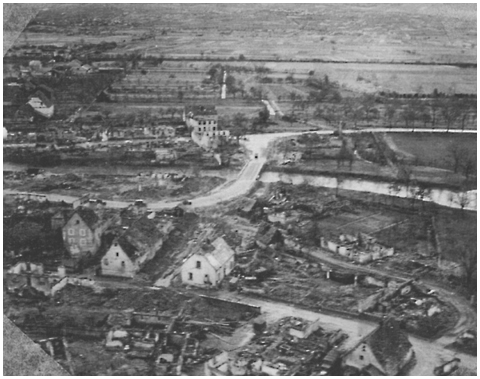
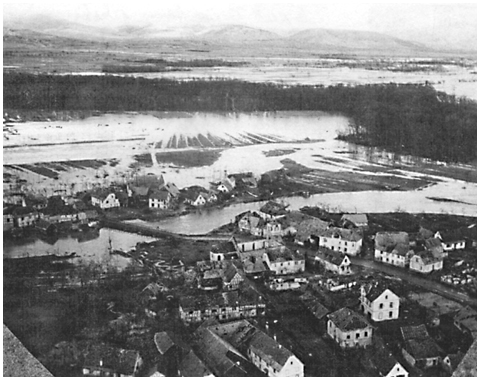
These photos show the villages in the Colmar Pocket. You can see the bridges the engineers had to build to be able to move across the canals. It looks like the water table is a few feet below ground surface, that meant pretty wet foxholes.
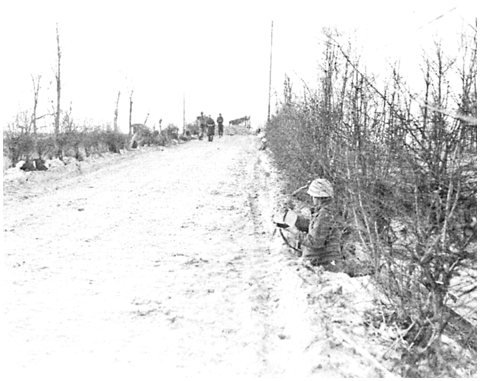
The B Company Bailey Bridge of the 10th Engineers across the Colmar Canal, South of Holzwihr in the Colmar Pocket. Look at those guys in those cold fox holes. All the action was going on here and in the Ardennes at the Battle of the Bulge.
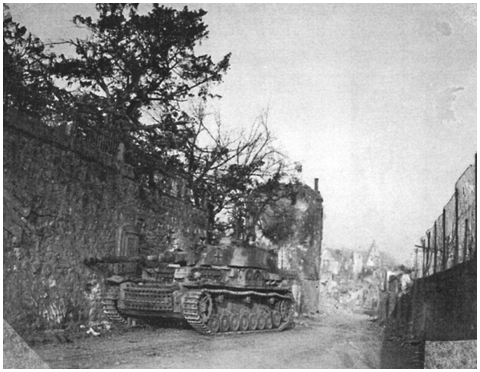
A KOd German Mark IV Tiger tank in Bennwihr.
Epilogue to "Sac"
"Sac, I have told my story through the Alsace winter of 1944 and I want to tell you how thankful I am that you have served me over two years without ever changing the sheets. But the powers that be have issued a new green sleeping bag for winter with wool interliners that can be removed. The bag is reported to be filled with chopped up chicken feathers. They are called mummy bags, and if you don't turn the bag when you turn you could suffocate. Sadly I say goodbye Sac but I promise to remember you, and maybe someday I will tell your story."
"Oh Great Unwashed you dirty S.O.B.!"
Howard B. Nickelson |
Introduction |
Drafted |
Operation Torch.
Conversation Part 1 |
Sicily |
Conversation Part 2 |
Anzio
Breakout |
France |
Germany |
Austria
Memoir appears by permission |